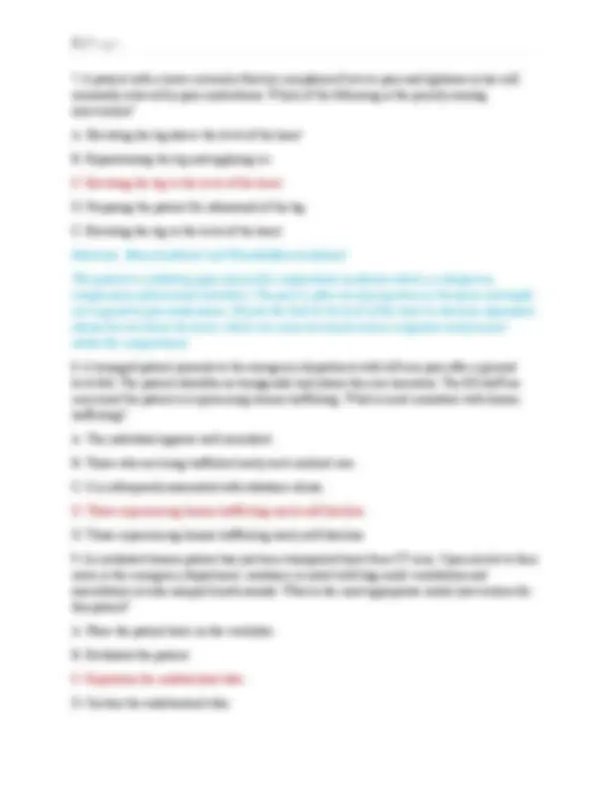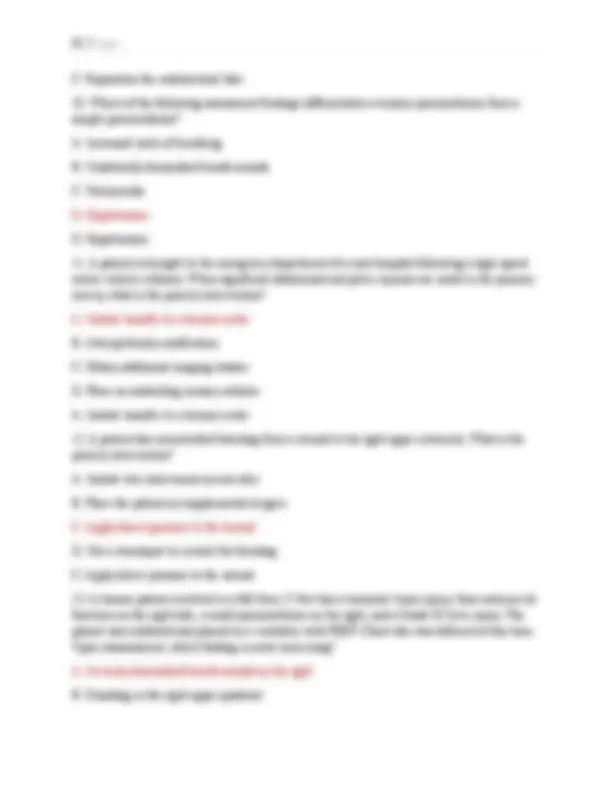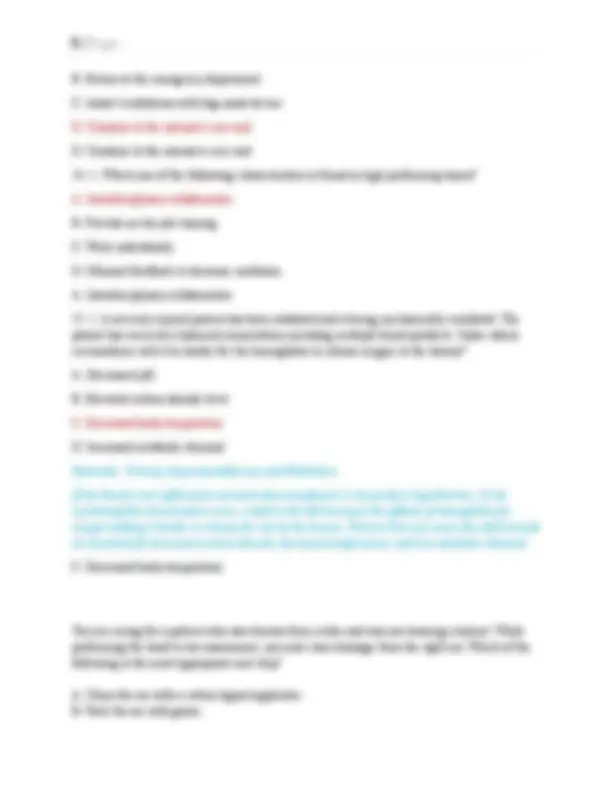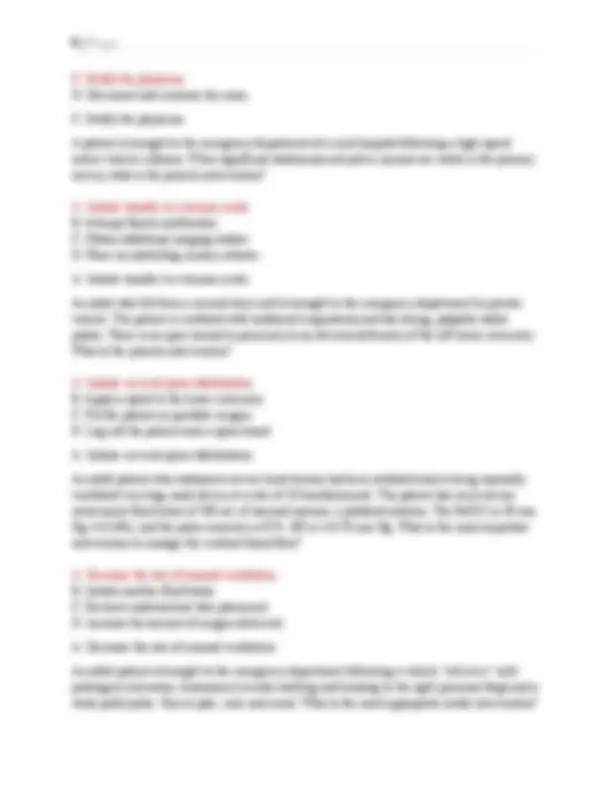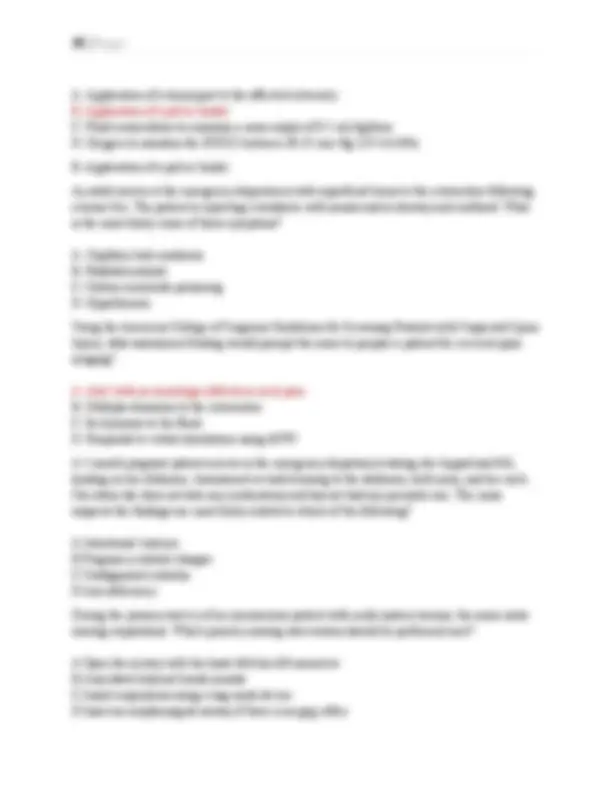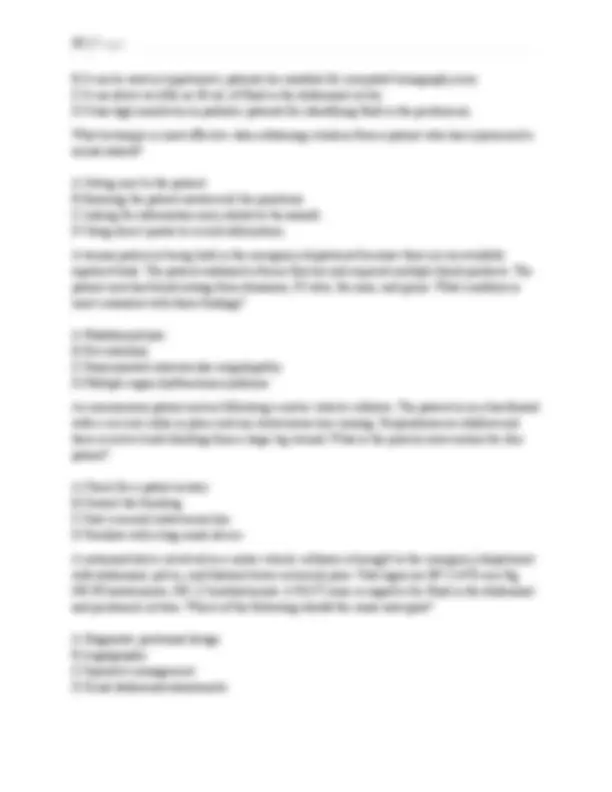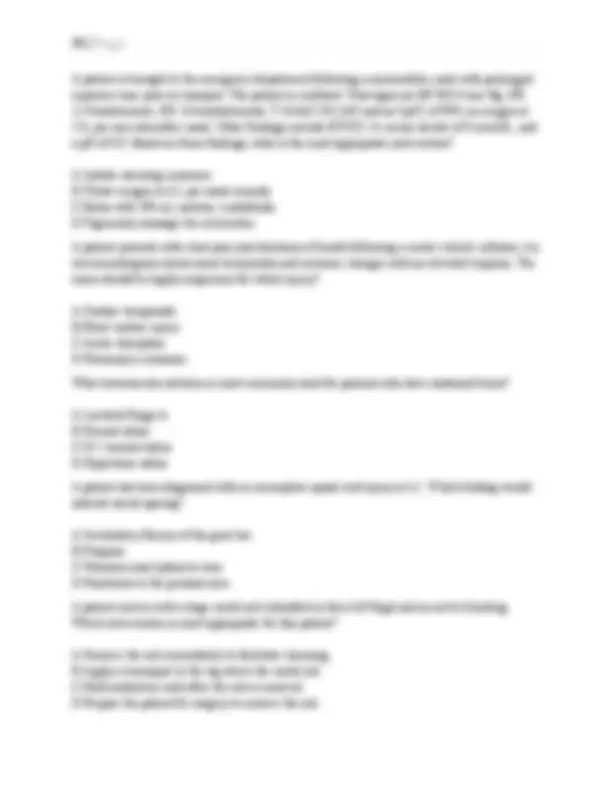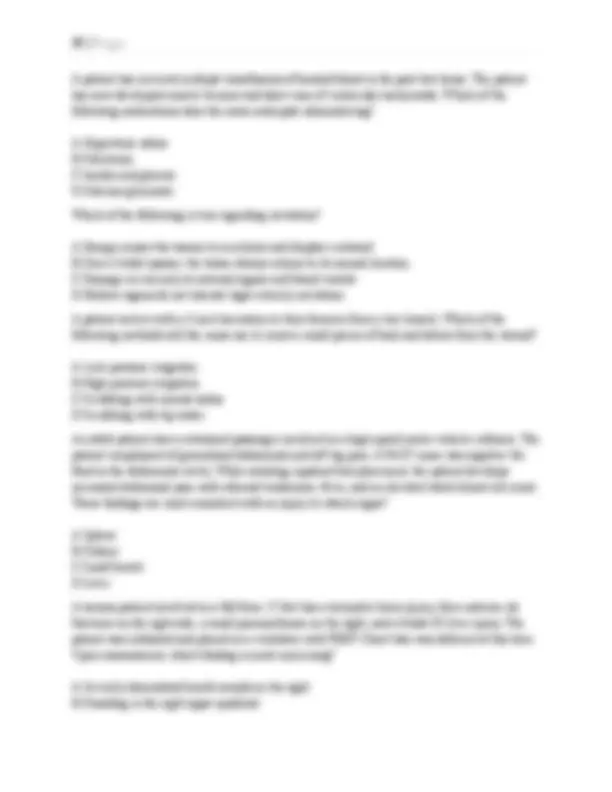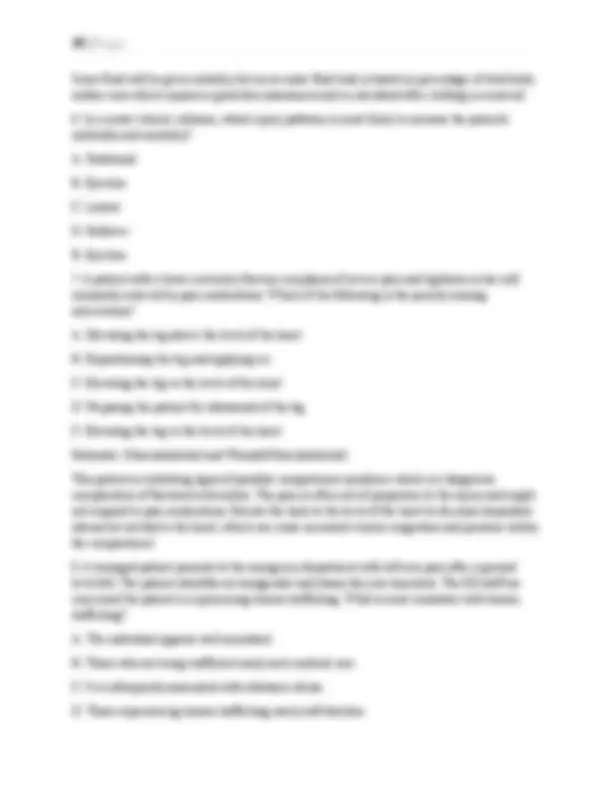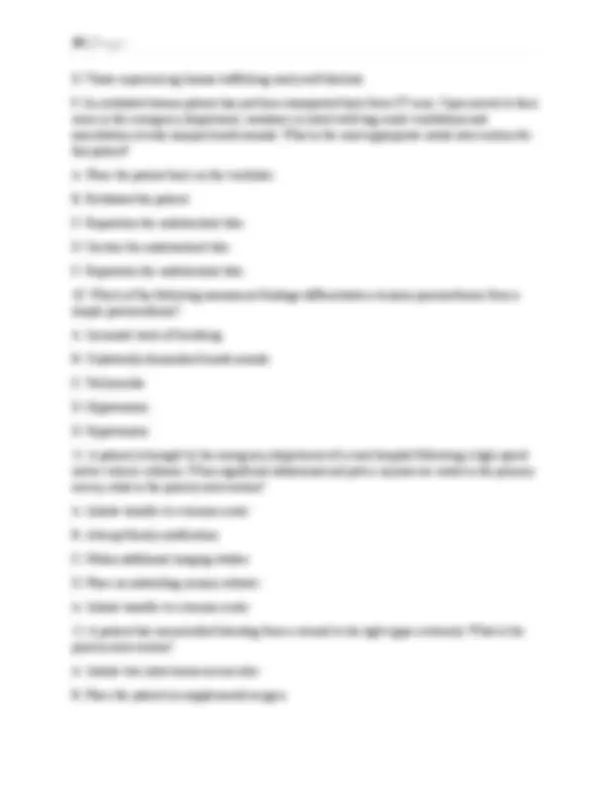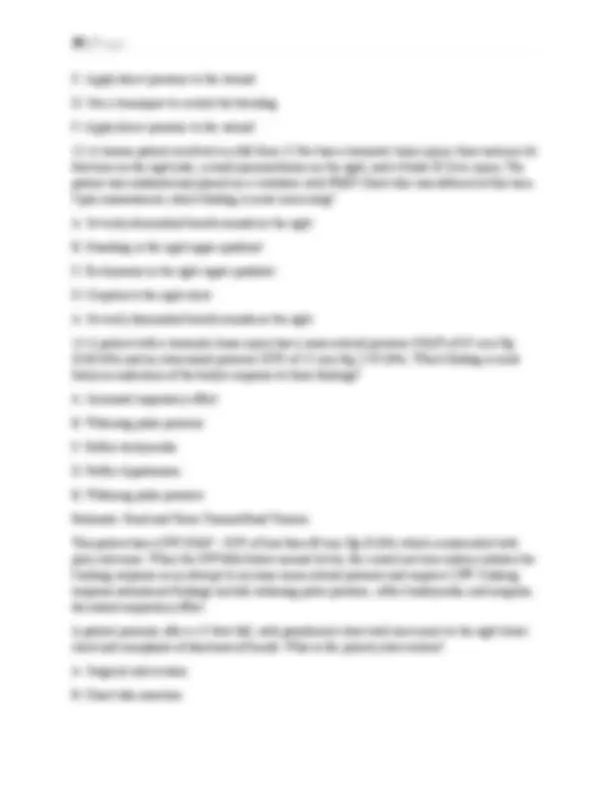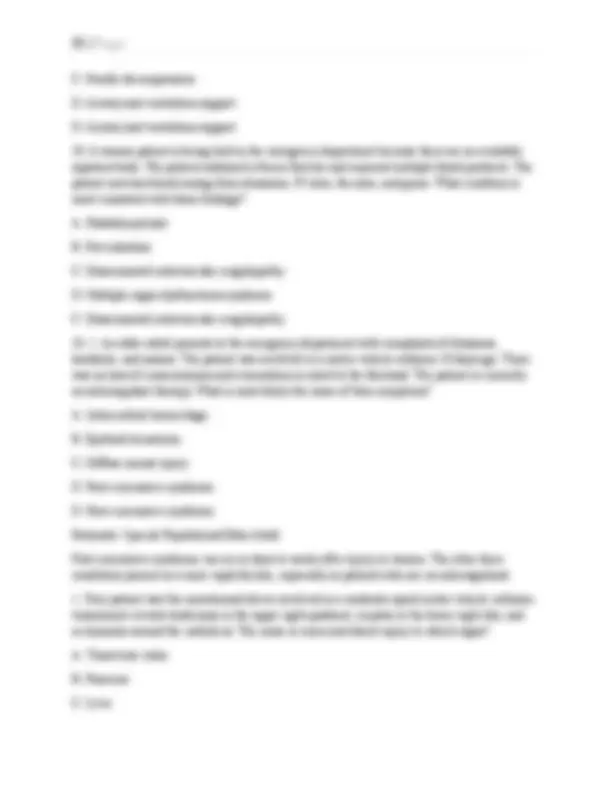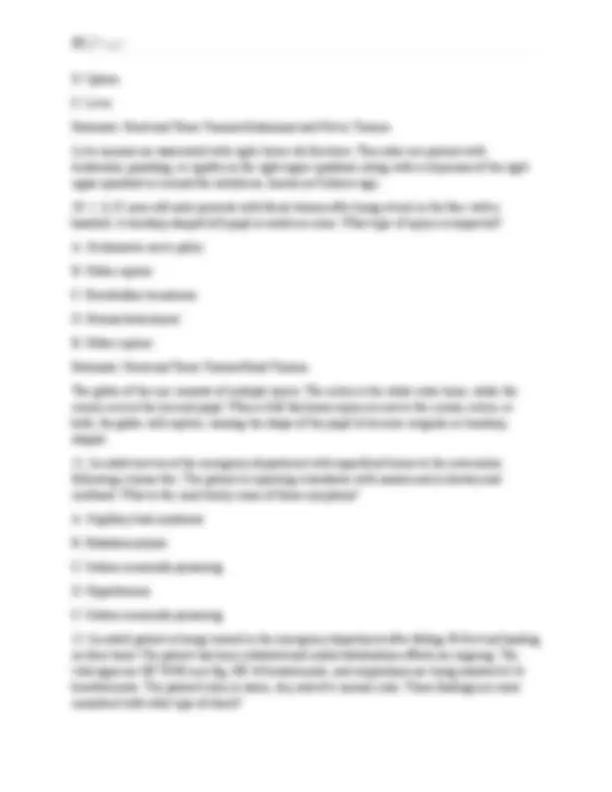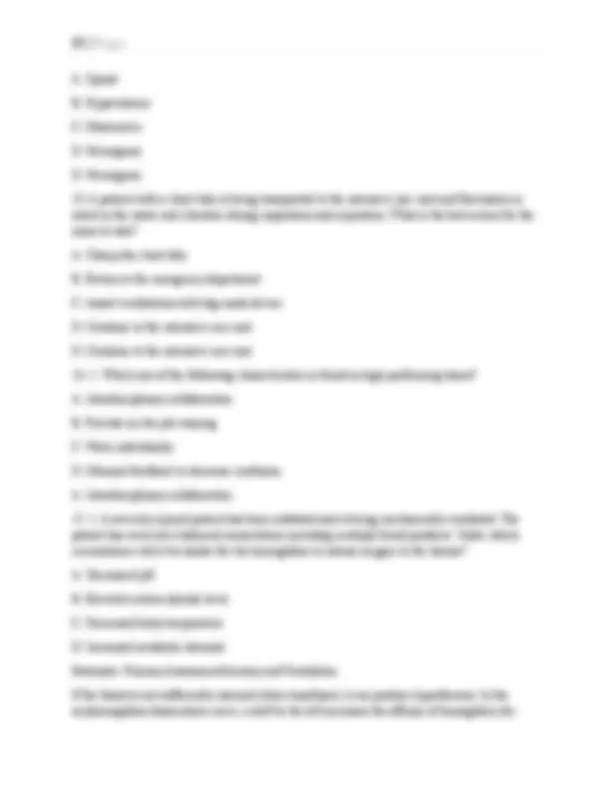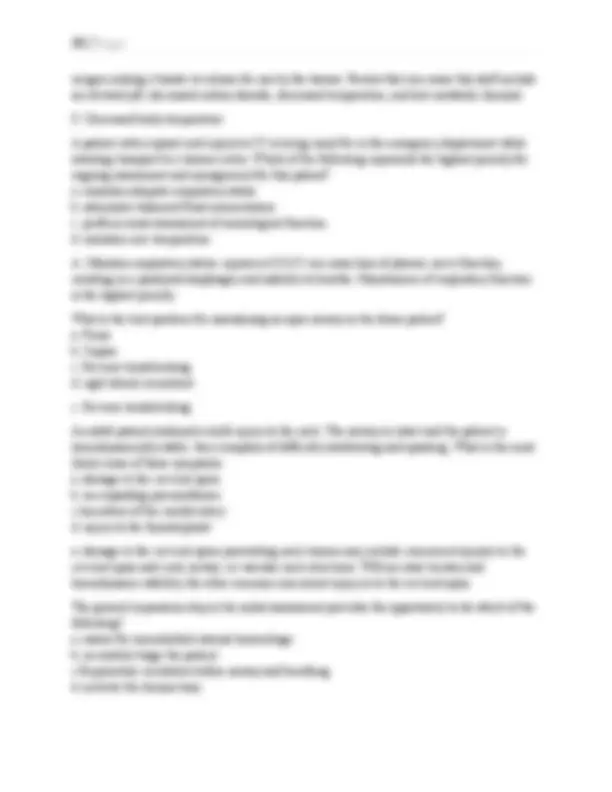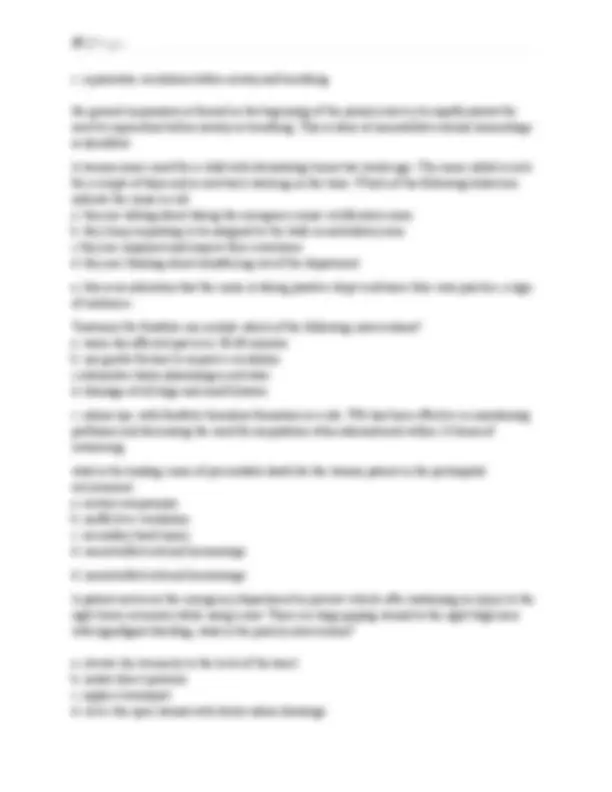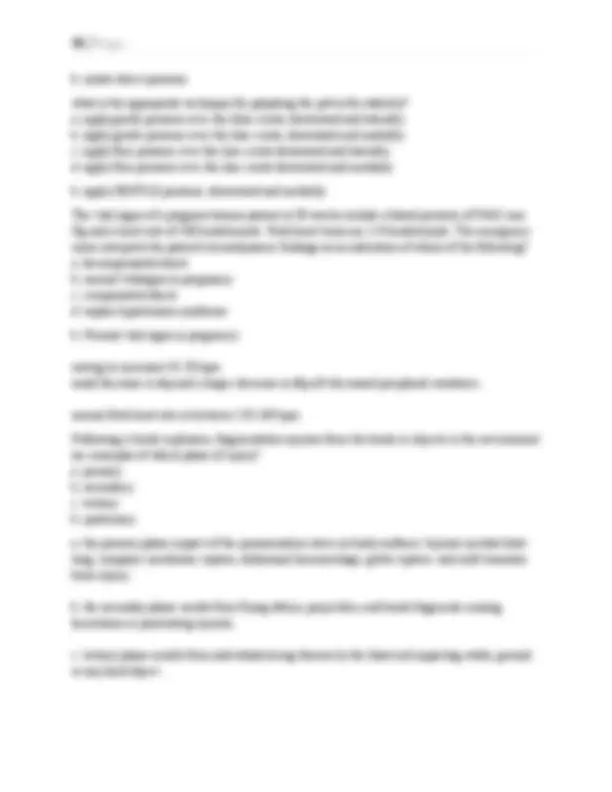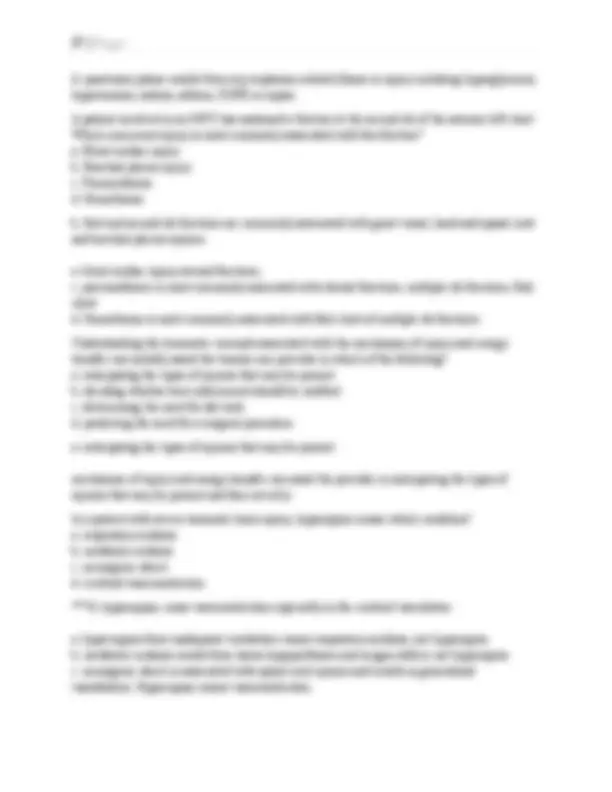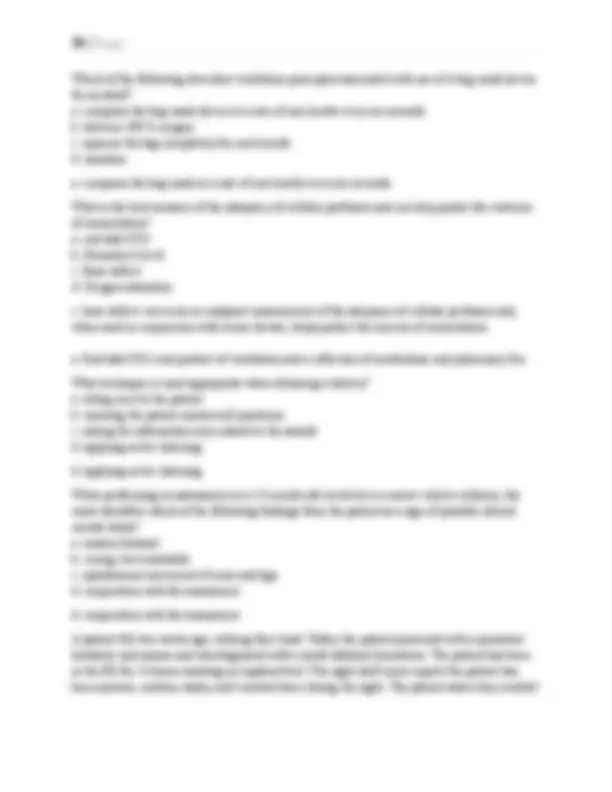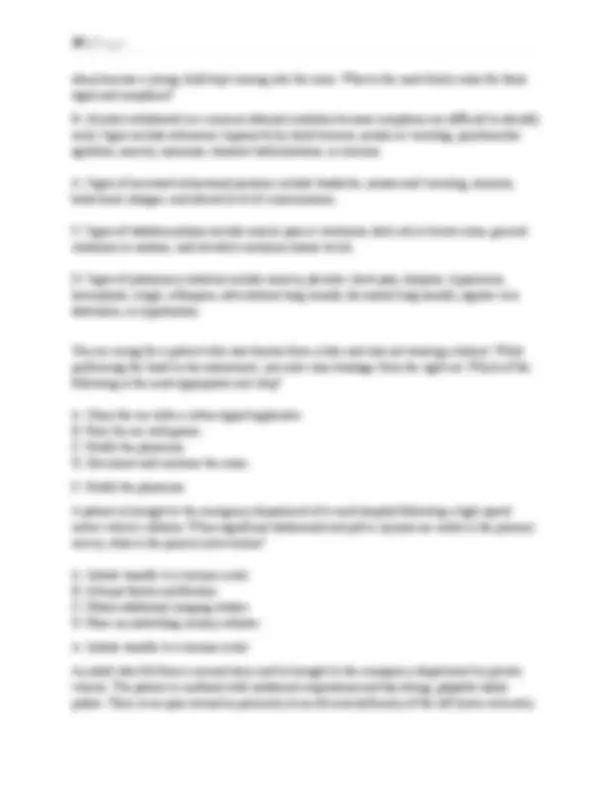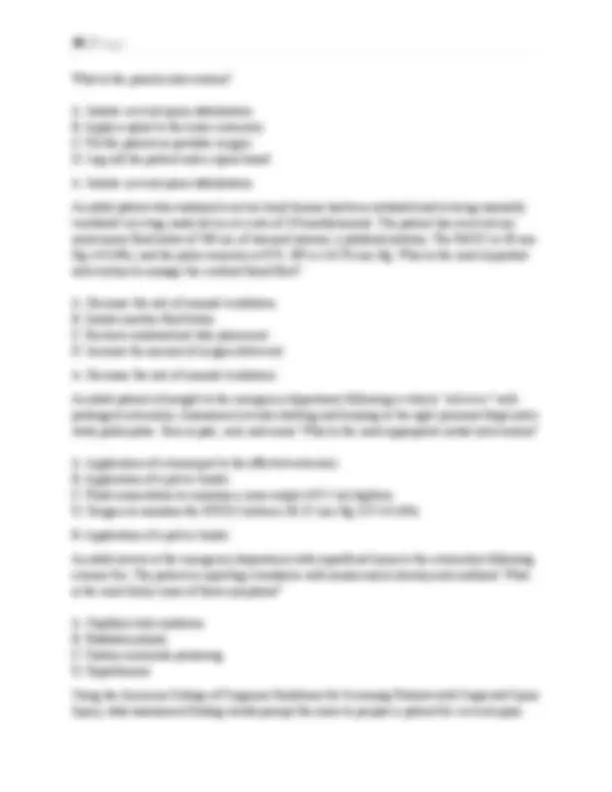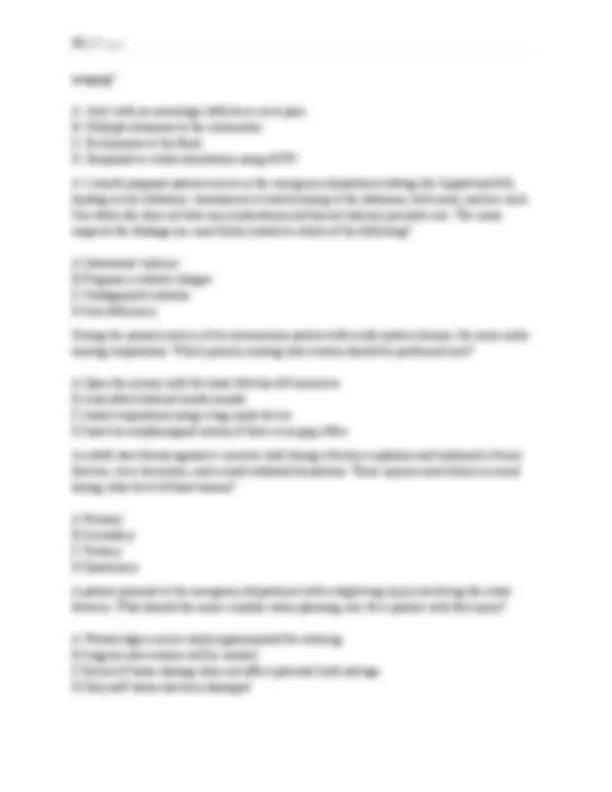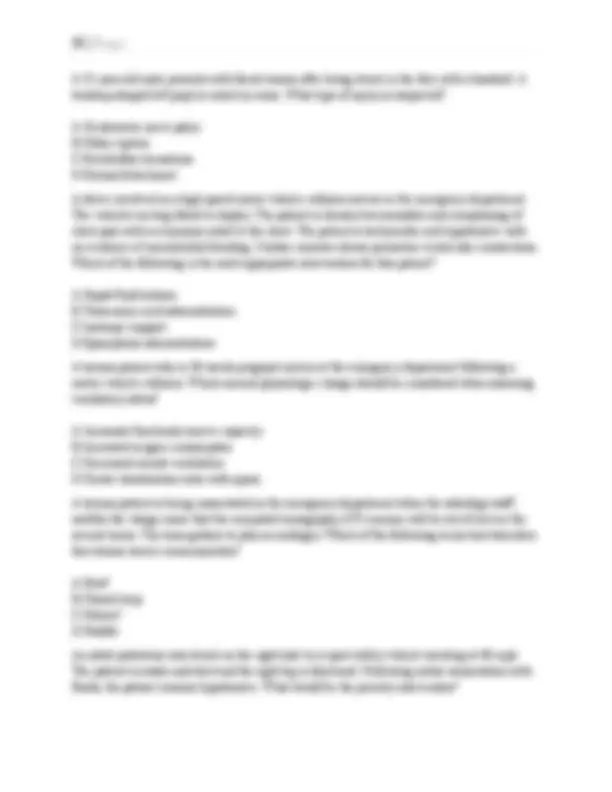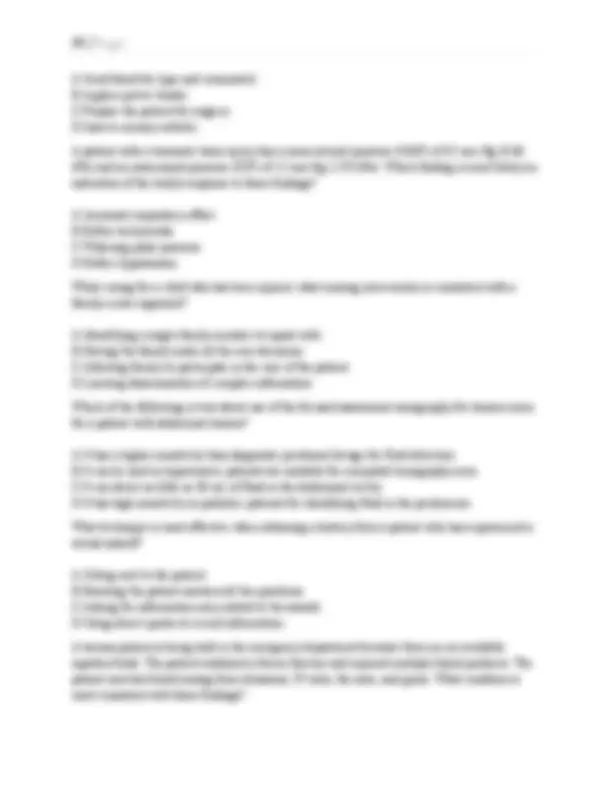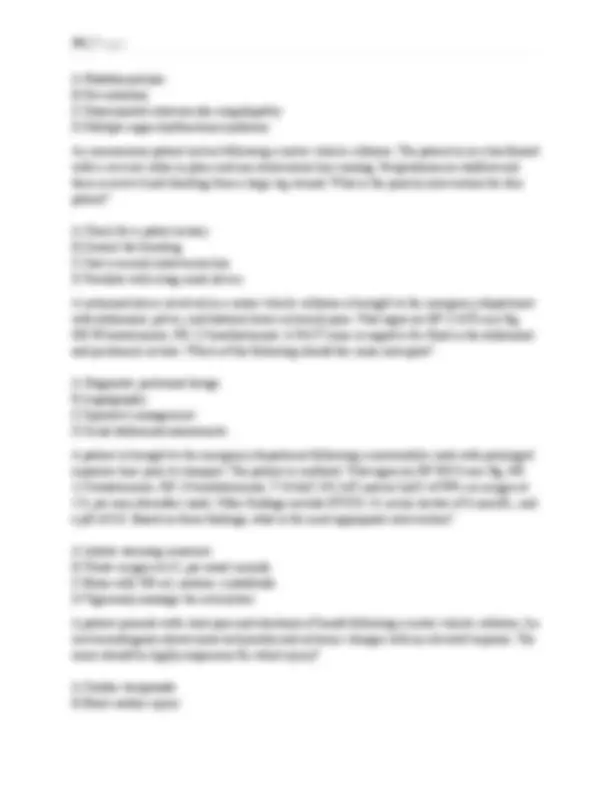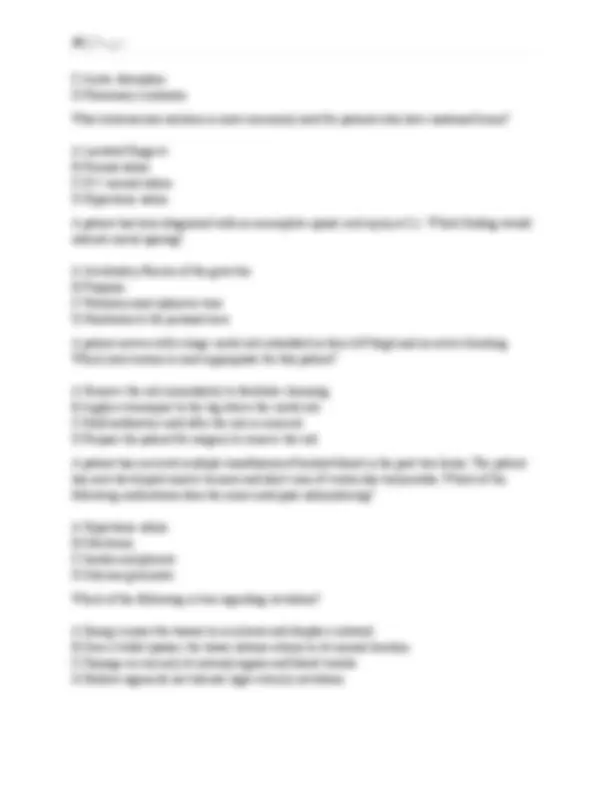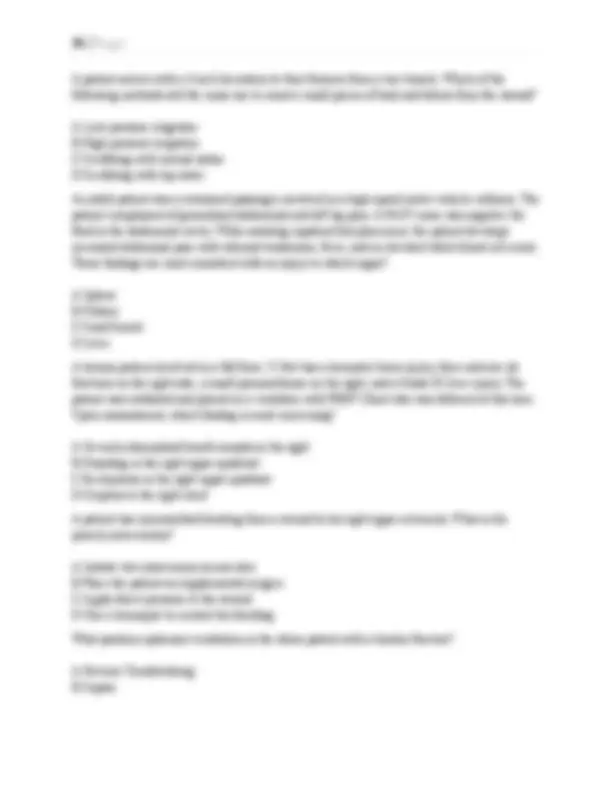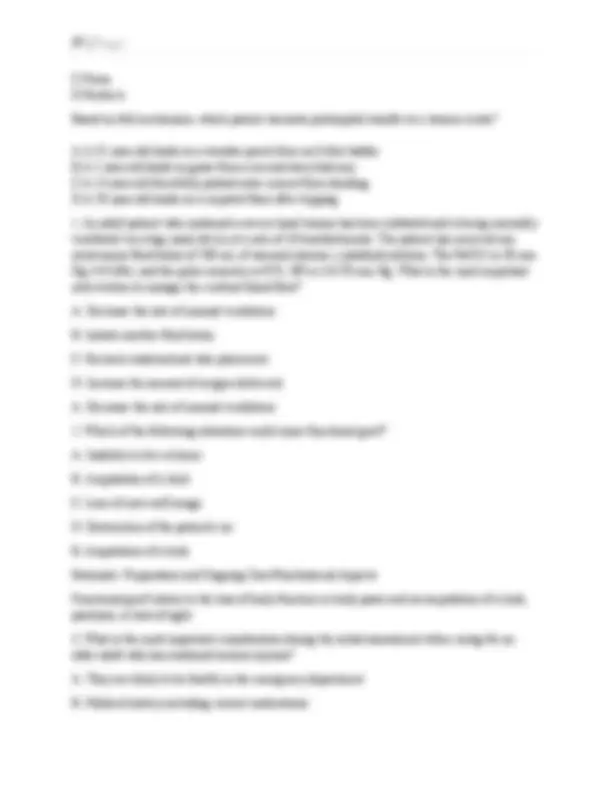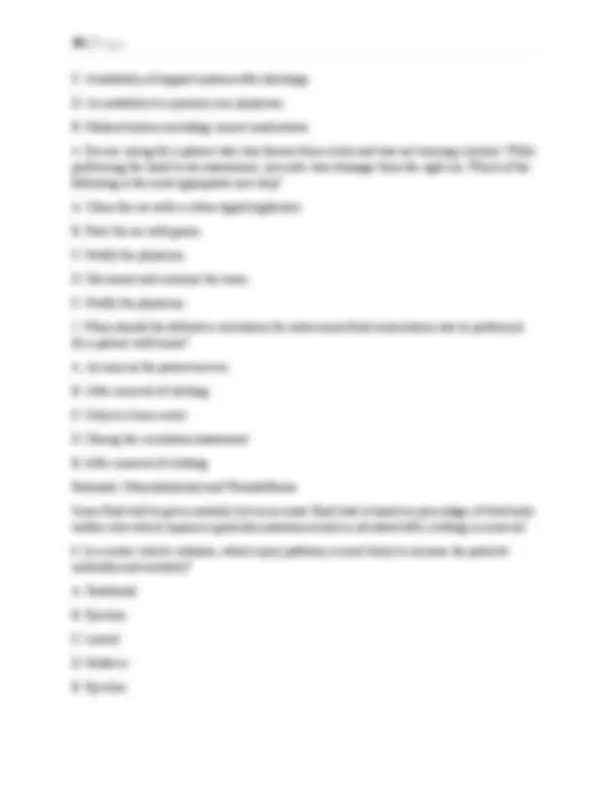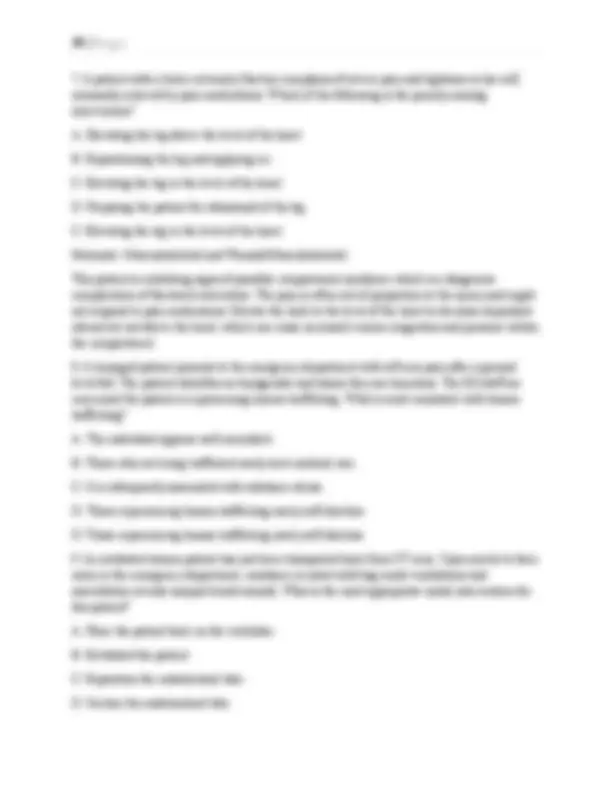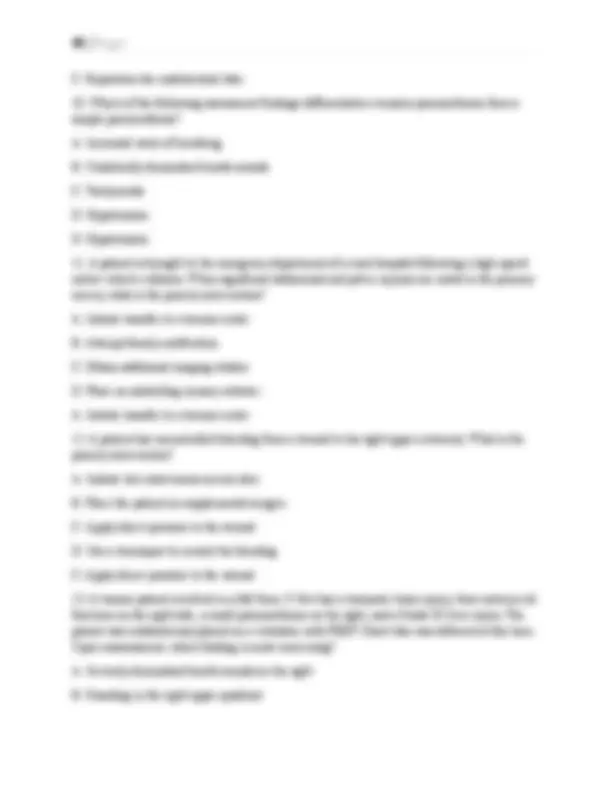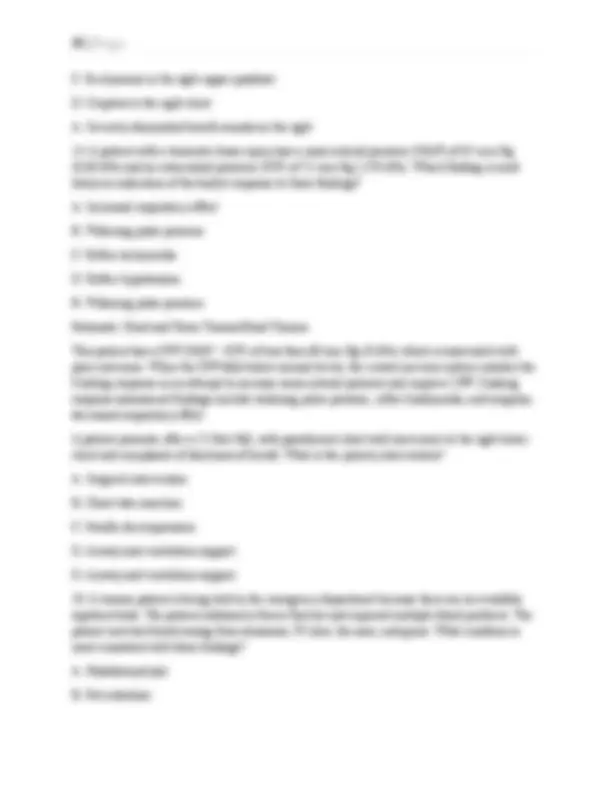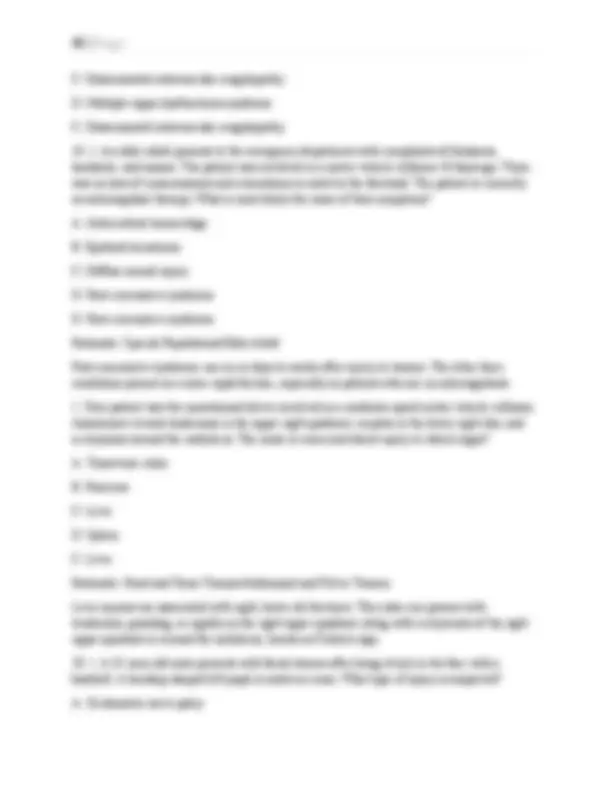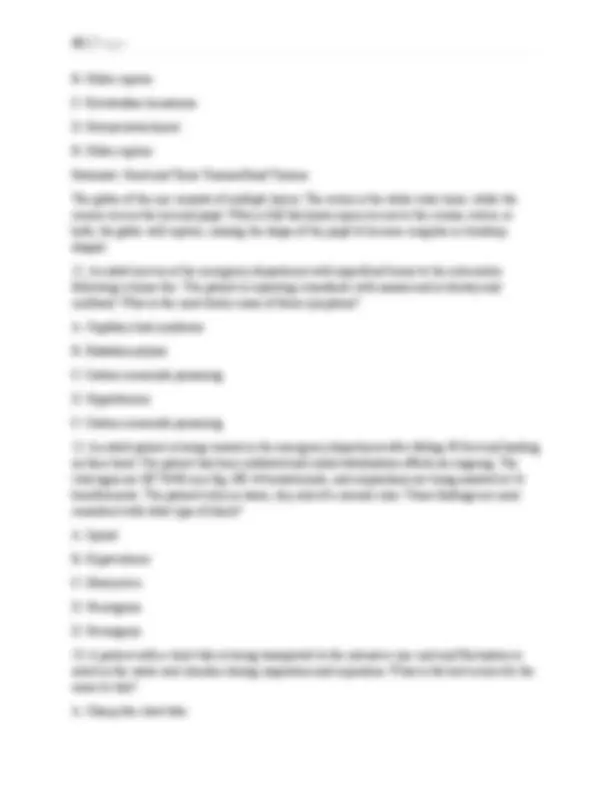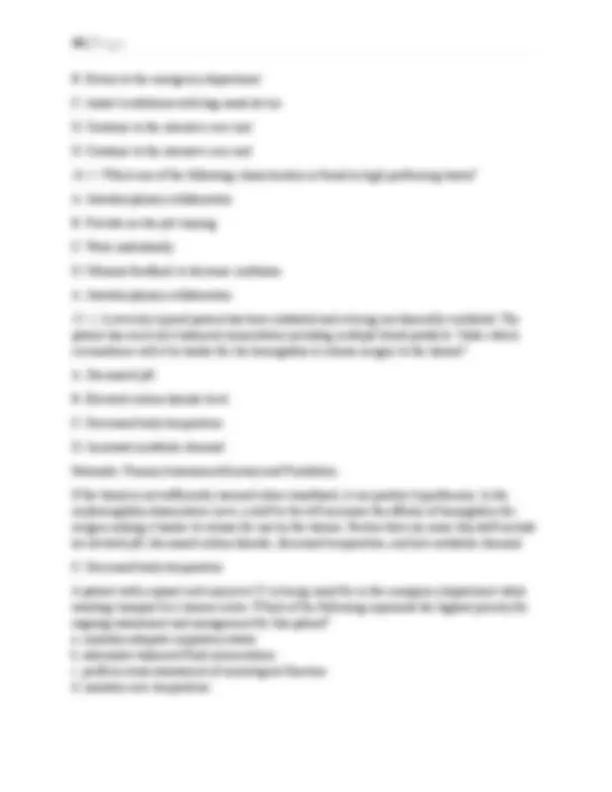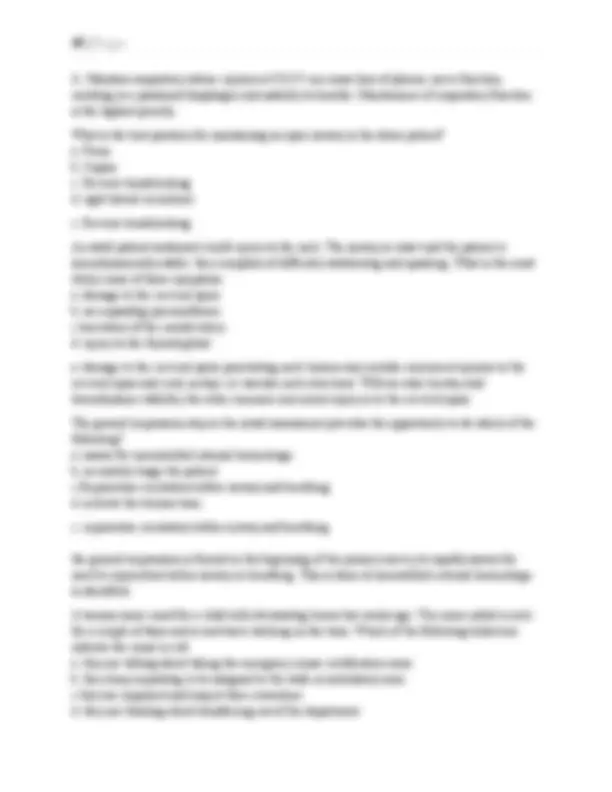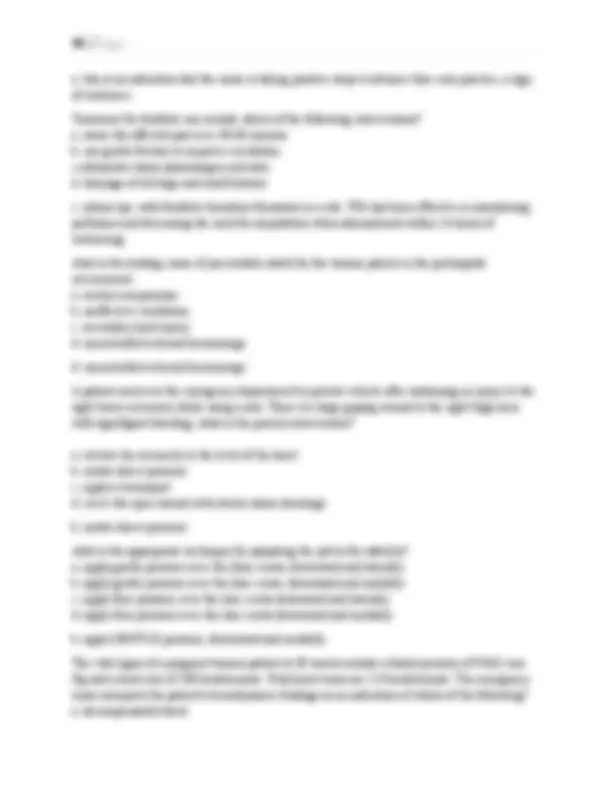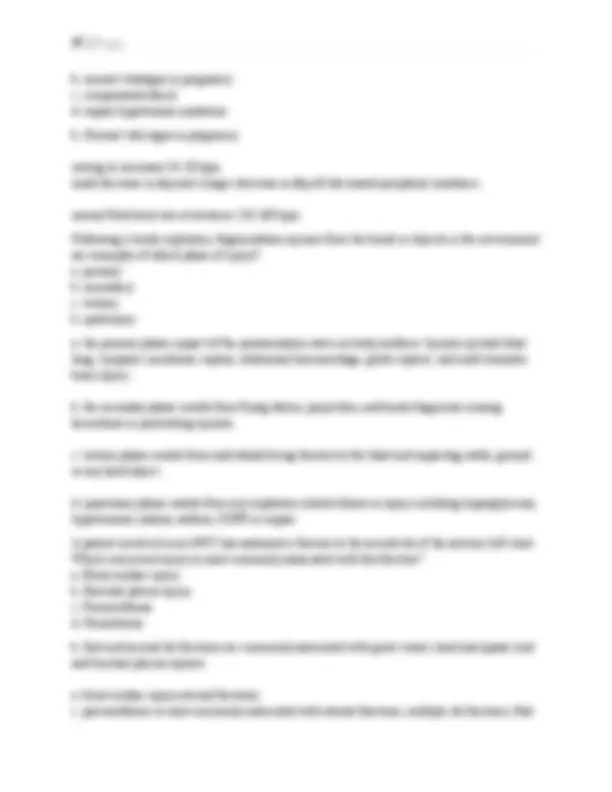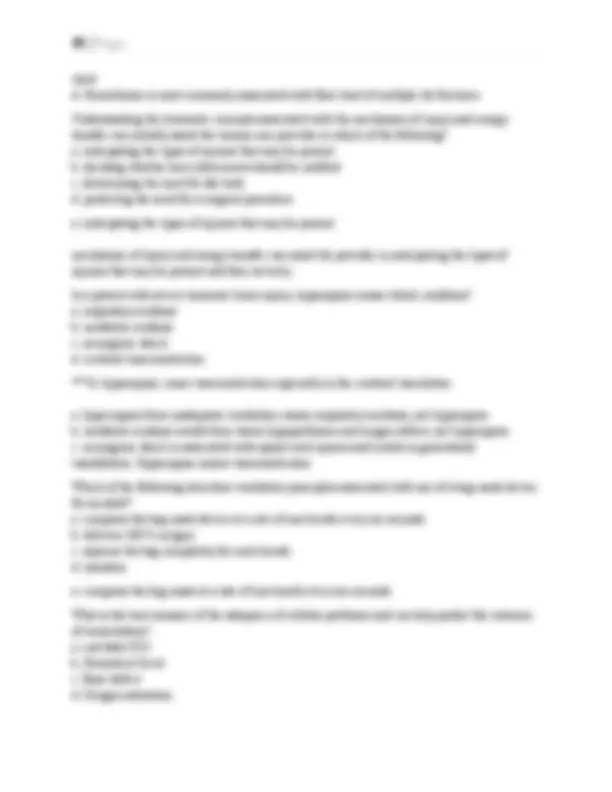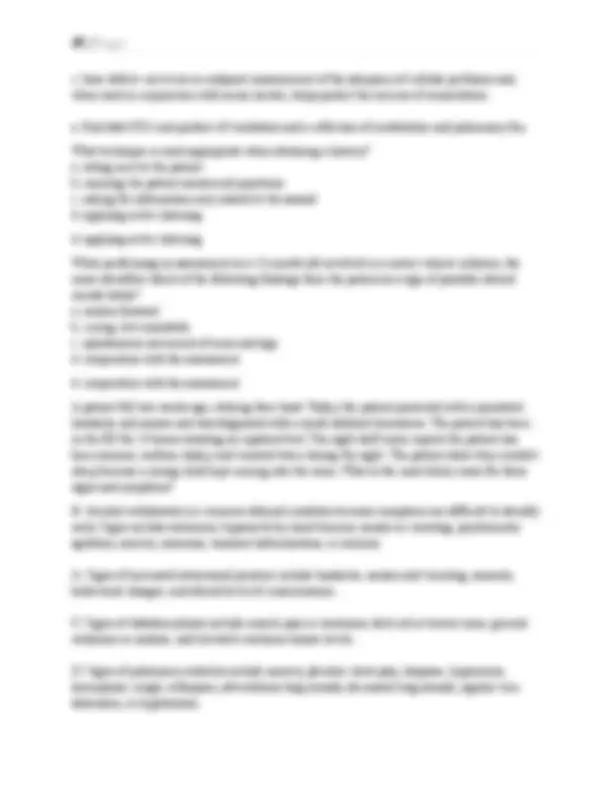Download TNCC 9TH EDITION FINAL TEST QUESTIONS AND ANSWERS WITH VERIFIED RATIONALES LATEST UPDATED and more Exams Nursing in PDF only on Docsity!
TNCC 9TH EDITION FINAL TEST
QUESTIONS AND ANSWERS WITH
VERIFIED RATIONALES LATEST
UPDATED 2025 AND ACCURATE
- An adult patient who sustained a severe head trauma has been intubated and is being manually ventilated via a bag-mask device at a rate of 18 breaths/minute. The patient has received one intravenous fluid bolus of 500 mL of warmed isotonic crystalloid solution. The PaCO2 is 30 mm Hg (4.0 kPa), and the pulse oximetry is 92%. BP is 142/70 mm Hg. What is the most important intervention to manage the cerebral blood flow? A. Decrease the rate of manual ventilation B. Initiate another fluid bolus. C. Recheck endotracheal tube placement. D. Increase the amount of oxygen delivered. A. Decrease the rate of manual ventilation
- Which of the following situations could cause functional grief? A. Inability to live at home B. Amputation of a limb C. Loss of one's self-image D. Destruction of the patient's car B. Amputation of a limb Rationale: Preparation and Ongoing Care\Psychosocial Aspects Functional grief relates to the loss of body function or body parts such as amputation of a limb, paralysis, or loss of sight.
- What is the most important consideration during the initial assessment when caring for an older adult who has sustained serious injuries? A. They are likely to be fearful in the emergency department
B. Medical history including current medications C. Availability of support systems after discharge D. Accessibility to a primary care physician B. Medical history including current medications
- You are caring for a patient who was thrown from a bike and was not wearing a helmet. While performing the head-to-toe assessment, you note clear drainage from the right ear. Which of the following is the most appropriate next step? A. Clean the ear with a cotton-tipped applicator. B. Pack the ear with gauze. C. Notify the physician D. Document and continue the exam. C. Notify the physician
- When should the definitive calculation for intravenous fluid resuscitation rate be performed for a patient with burns? A. As soon as the patient arrives B. After removal of clothing C. Only at a burn center D. During the circulation assessment B. After removal of clothing Rationale: Musculoskeletal and Wounds\Burns Some fluid will be given initially, but an accurate fluid total is based on percentage of total body surface area which requires a good skin assessment and is calculated after clothing is removed.
- In a motor vehicle collision, which injury pathway is most likely to increase the patient's morbidity and mortality? A. Rotational B. Ejection C. Lateral D. Rollover B. Ejection
C. Reposition the endotracheal tube.
- Which of the following assessment findings differentiates a tension pneumothorax from a simple pneumothorax? A. Increased work of breathing B. Unilaterally diminished breath sounds C. Tachycardia D. Hypotension D. Hypotension
- A patient is brought to the emergency department of a rural hospital following a high-speed motor vehicle collision. When significant abdominal and pelvic injuries are noted in the primary survey, what is the priority intervention? A. Initiate transfer to a trauma center B. Attempt family notification C. Obtain additional imaging studies D. Place an indwelling urinary catheter A. Initiate transfer to a trauma center
- A patient has uncontrolled bleeding from a wound to his right upper extremity. What is the priority intervention? A. Initiate two intravenous access sites B. Place the patient on supplemental oxygen C. Apply direct pressure to the wound D. Use a tourniquet to control the bleeding C. Apply direct pressure to the wound
- A trauma patient involved in a fall from 25 feet has a traumatic brain injury, three anterior rib fractures on the right side, a small pneumothorax on the right, and a Grade III liver injury. The patient was intubated and placed on a ventilator with PEEP. Chest tube was deferred at this time. Upon reassessment, which finding is most concerning? A. Severely diminished breath sounds on the right B. Guarding in the right upper quadrant
C. Ecchymosis in the right upper quadrant D. Crepitus to the right chest A. Severely diminished breath sounds on the right
- A patient with a traumatic brain injury has a mean arterial pressure (MAP) of 65 mm Hg (8.66 kPa) and an intracranial pressure (ICP) of 22 mm Hg (2.93 kPa). Which finding is most likely an indication of the body's response to these findings? A. Increased respiratory effort B. Widening pulse pressure C. Reflex tachycardia D. Reflex hypotension B. Widening pulse pressure Rationale: Head and Torso Trauma\Head Trauma This patient has a CPP (MAP − ICP) of less than 60 mm Hg (8 kPa) which is associated with poor outcomes. When the CPP falls below normal levels, the central nervous system initiates the Cushing response in an attempt to increase mean arterial pressure and improve CPP. Cushing response assessment findings include widening pulse pressure, reflex bradycardia, and irregular, decreased respiratory effort. A patient presents, after a 25-foot fall, with paradoxical chest wall movement to the right lower chest and complaints of shortness of breath. What is the priority intervention? A. Surgical intervention B. Chest tube insertion C. Needle decompression D. Airway and ventilation support D. Airway and ventilation support
- A trauma patient is being held in the emergency department because there are no available inpatient beds. The patient sustained a femur fracture and required multiple blood products. The patient now has blood oozing from abrasions, IV sites, the nose, and gums. What condition is most consistent with these findings? A. Rhabdomyolysis B. Fat embolism
B. Globe rupture C. Retrobulbar hematoma D. Retinal detachment B. Globe rupture Rationale: Head and Torso Trauma\Head Trauma The globe of the eye consists of multiple layers. The sclera is the white outer layer, while the cornea covers the iris and pupil. When a full thickness injury occurs to the cornea, sclera, or both, the globe will rupture, causing the shape of the pupil to become irregular or teardrop- shaped
- An adult arrives at the emergency department with superficial burns to the extremities following a house fire. The patient is reporting a headache with nausea and is drowsy and confused. What is the most likely cause of these symptoms? A. Capillary leak syndrome B. Rhabdomyolysis C. Carbon monoxide poisoning D. Hypothermia C. Carbon monoxide poisoning
- An adult patient is being treated in the emergency department after falling 30 feet and landing on their head. The patient has been intubated and initial stabilization efforts are ongoing. The vital signs are BP 70/40 mm Hg, HR 44 beats/minute, and respirations are being assisted at 16 breath/minute. The patient's skin is warm, dry, and of a normal color. These findings are most consistent with what type of shock? A. Spinal B. Hypovolemic C. Obstructive D. Neurogenic D. Neurogenic
- A patient with a chest tube is being transported to the intensive care unit and fluctuation is noted in the water seal chamber during inspiration and expiration. What is the best action for the nurse to take? A. Clamp the chest tube
B. Return to the emergency department C. Assist ventilations with bag-mask device D. Continue to the intensive care unit D. Continue to the intensive care unit
- Which one of the following characteristics is found in high performing teams? A. Interdisciplinary collaboration B. Provide on-the-job training C. Work individually D. Minimal feedback to decrease confusion A. Interdisciplinary collaboration
- A severely injured patient has been intubated and is being mechanically ventilated. The patient has received a balanced resuscitation including multiple blood products. Under which circumstance will it be harder for the hemoglobin to release oxygen to the tissues? A. Decreased pH B. Elevated carbon dioxide level C. Decreased body temperature D. Increased metabolic demand Rationale: Primary Assessment\Airway and Ventilation If the blood is not sufficiently warmed when transfused, it can produce hypothermia. In the oxyhemoglobin dissociation curve, a shift to the left increases the affinity of hemoglobin for oxygen making it harder to release for use by the tissues. Factors that can cause this shift include an elevated pH, decreased carbon dioxide, decreased temperature, and low metabolic demand. C. Decreased body temperature You are caring for a patient who was thrown from a bike and was not wearing a helmet. While performing the head-to-toe assessment, you note clear drainage from the right ear. Which of the following is the most appropriate next step? A. Clean the ear with a cotton-tipped applicator. B. Pack the ear with gauze.
A. Application of a tourniquet to the affected extremity B. Application of a pelvic binder C. Fluid resuscitation to maintain a urine output of 0.5 mL/kg/hour D. Oxygen to maintain the ETCO2 between 30-35 mm Hg (3.9-4.6 kPa) B. Application of a pelvic binder An adult arrives at the emergency department with superficial burns to the extremities following a house fire. The patient is reporting a headache with nausea and is drowsy and confused. What is the most likely cause of these symptoms? A. Capillary leak syndrome B. Rhabdomyolysis C. Carbon monoxide poisoning D. Hypothermia Using the American College of Surgeons Guidelines for Screening Patients with Suspected Spine Injury, what assessment finding would prompt the nurse to prepare a patient for cervical spine imaging? A. Alert with no neurologic deficits or neck pain B. Multiple abrasions to the extremities C. Ecchymosis to the flank D. Responds to verbal stimulation using AVPU A 5-month pregnant patient arrives in the emergency department stating she tripped and fell, landing on her abdomen. Assessment reveals bruising to the abdomen, both arms, and her neck. She states she does not take any medications and has not had any prenatal care. The nurse suspects the findings are most likely related to which of the following? A.Intentional violence B.Pregnancy-related changes C.Undiagnosed embolus D.Iron deficiency During the primary survey of an unconscious patient with multi-system trauma, the nurse notes snoring respirations. Which priority nursing intervention should be performed next? A.Open the airway with the head-tilt/chin-lift maneuver B.Auscultate bilateral breath sounds C.Assist respirations using a bag-mask device D.Insert an oropharyngeal airway if there is no gag reflex
An adult was thrown against a concrete wall during a factory explosion and sustained a femur fracture, liver laceration, and a small subdural hematoma. These injuries most likely occurred during what level of blast trauma? A.Primary B.Secondary C.Tertiary D.Quaternary A patient presents to the emergency department with a degloving injury involving the entire forearm. What should the nurse consider when planning care for a patient with this injury? A.Wound edges can be easily approximated for suturing. B.Surgical intervention will be needed C.Extent of tissue damage does not affect potential limb salvage D.Only soft tissue has been damaged A 35-year-old male presents with facial trauma after being struck in the face with a baseball. A teardrop-shaped left pupil is noted on exam. What type of injury is suspected? A.Oculomotor nerve palsy B.Globe rupture C.Retrobulbar hematoma D.Retinal detachment A driver involved in a high-speed motor vehicle collision arrives in the emergency department. The vehicle's air-bag failed to deploy. The patient is drowsy but arousable and complaining of chest pain with ecchymosis noted to the chest. The patient is tachycardic and hypotensive with no evidence of uncontrolled bleeding. Cardiac monitor shows premature ventricular contractions. Which of the following is the most appropriate intervention for this patient? A.Rapid fluid boluses B.Tranexamic acid administration C.Inotropic support D.Epinephrine administration A trauma patient who is 30-weeks pregnant arrives at the emergency department following a motor vehicle collision. Which normal physiologic change should be considered when assessing ventilatory status? A.Increased functional reserve capacity B.Increased oxygen consumption
B.It can be used in hypotensive patients too unstable for computed tomography scan C.It can detect as little as 30 mL of fluid in the abdominal cavity D.It has high sensitivity in pediatric patients for identifying fluid in the peritoneum What technique is most effective when obtaining a history from a patient who has experienced a sexual assault? A.Sitting next to the patient. B.Ensuring the patient answers all the questions. C.Asking for information only related to the assault. D.Using direct quotes to record information. A trauma patient is being held in the emergency department because there are no available inpatient beds. The patient sustained a femur fracture and required multiple blood products. The patient now has blood oozing from abrasions, IV sites, the nose, and gums. What condition is most consistent with these findings? A.Rhabdomyolysis B.Fat embolism C.Disseminated intravascular coagulopathy D.Multiple organ dysfunctions syndrome An unconscious patient arrives following a motor vehicle collision. The patient is on a backboard with a cervical collar in place and one intravenous line running. Respirations are shallow and there is active brisk bleeding from a large leg wound. What is the priority intervention for this patient? A.Check for a patent airway B.Control the bleeding C.Start a second intravenous line D.Ventilate with a bag-mask device A restrained driver involved in a motor vehicle collision is brought to the emergency department with abdominal, pelvic, and bilateral lower extremity pain. Vital signs are BP 114/78 mm Hg, HR 98 beats/minute, RR 22 breaths/minute. A FAST exam is negative for fluid in the abdominal and peritoneal cavities. Which of the following should the nurse anticipate? A.Diagnostic peritoneal lavage B.Angiography C.Operative management D.Serial abdominal assessments
A patient is brought to the emergency department following a snowmobile crash with prolonged exposure time prior to transport. The patient is confused. Vital signs are BP 96/54 mm Hg, HR 114 beats/minute, RR 24 breaths/minute, T 34.6oC (94.2oF) and an SpO2 of 90% on oxygen at 15L per non-rebreather mask. Other findings include ETCO2 24, serum lactate of 6 mmol/L, and a pH of 6.8. Based on these findings, what is the most appropriate intervention? A.Initiate warming measures B.Titrate oxygen to 6 L per nasal cannula C.Bolus with 500 mL isotonic crystalloids D.Vigorously massage the extremities A patient presents with chest pain and shortness of breath following a motor vehicle collision. An electrocardiogram shows sinus tachycardia and ischemic changes with an elevated troponin. The nurse should be highly suspicious for which injury? A.Cardiac tamponade B.Blunt cardiac injury C.Aortic disruption D.Pulmonary contusion What intravascular solution is most commonly used for patients who have sustained burns? A.Lactated Ringer's B.Normal saline C.D5 / normal saline D.Hypertonic saline A patient has been diagnosed with an incomplete spinal cord injury at L1. Which finding would indicate sacral sparing? A.Involuntary flexion of the great toe B.Priapism C.Voluntary anal sphincter tone D.Numbness to the perianal area A patient arrives with a large metal rod embedded in their left thigh and no active bleeding. Which intervention is most appropriate for this patient? A.Remove the rod immediately to facilitate cleansing. B.Apply a tourniquet to the leg above the metal rod. C.Hold antibiotics until after the rod is removed. D.Prepare the patient for surgery to remove the rod.
C.Ecchymosis in the right upper quadrant D.Crepitus to the right chest A patient has uncontrolled bleeding from a wound to his right upper extremity. What is the priority intervention? A.Initiate two intravenous access sites B.Place the patient on supplemental oxygen C.Apply direct pressure to the wound D.Use a tourniquet to control the bleeding What position optimizes ventilation in the obese patient with a lumbar fracture? A.Reverse Trendelenburg B.Supine C.Prone D.Fowler's Based on fall mechanism, which patient warrants prehospital transfer to a trauma center? A.A 35-year-old lands on a wooden porch from an 8-foot ladder B.A 2-year-old lands on grass from a second-story balcony C.A 14-year-old forcefully pushed onto cement from standing D.A 50-year-old lands on a carpeted floor after tripping
- An adult patient who sustained a severe head trauma has been intubated and is being manually ventilated via a bag-mask device at a rate of 18 breaths/minute. The patient has received one intravenous fluid bolus of 500 mL of warmed isotonic crystalloid solution. The PaCO2 is 30 mm Hg (4.0 kPa), and the pulse oximetry is 92%. BP is 142/70 mm Hg. What is the most important intervention to manage the cerebral blood flow? A. Decrease the rate of manual ventilation B. Initiate another fluid bolus. C. Recheck endotracheal tube placement. D. Increase the amount of oxygen delivered. A. Decrease the rate of manual ventilation
- Which of the following situations could cause functional grief? A. Inability to live at home B. Amputation of a limb
C. Loss of one's self-image D. Destruction of the patient's car B. Amputation of a limb Rationale: Preparation and Ongoing Care\Psychosocial Aspects Functional grief relates to the loss of body function or body parts such as amputation of a limb, paralysis, or loss of sight.
- What is the most important consideration during the initial assessment when caring for an older adult who has sustained serious injuries? A. They are likely to be fearful in the emergency department B. Medical history including current medications C. Availability of support systems after discharge D. Accessibility to a primary care physician B. Medical history including current medications
- You are caring for a patient who was thrown from a bike and was not wearing a helmet. While performing the head-to-toe assessment, you note clear drainage from the right ear. Which of the following is the most appropriate next step? A. Clean the ear with a cotton-tipped applicator. B. Pack the ear with gauze. C. Notify the physician D. Document and continue the exam. C. Notify the physician
- When should the definitive calculation for intravenous fluid resuscitation rate be performed for a patient with burns? A. As soon as the patient arrives B. After removal of clothing C. Only at a burn center D. During the circulation assessment B. After removal of clothing Rationale: Musculoskeletal and Wounds\Burns
D. Those experiencing human trafficking rarely self-disclose.
- An intubated trauma patient has just been transported back from CT scan. Upon arrival to their room in the emergency department, resistance is noted with bag-mask ventilations and auscultation reveals unequal breath sounds. What is the most appropriate initial intervention for this patient? A. Place the patient back on the ventilator. B. Extubated the patient. C. Reposition the endotracheal tube. D. Suction the endotracheal tube. C. Reposition the endotracheal tube.
- Which of the following assessment findings differentiates a tension pneumothorax from a simple pneumothorax? A. Increased work of breathing B. Unilaterally diminished breath sounds C. Tachycardia D. Hypotension D. Hypotension
- A patient is brought to the emergency department of a rural hospital following a high-speed motor vehicle collision. When significant abdominal and pelvic injuries are noted in the primary survey, what is the priority intervention? A. Initiate transfer to a trauma center B. Attempt family notification C. Obtain additional imaging studies D. Place an indwelling urinary catheter A. Initiate transfer to a trauma center
- A patient has uncontrolled bleeding from a wound to his right upper extremity. What is the priority intervention? A. Initiate two intravenous access sites B. Place the patient on supplemental oxygen
C. Apply direct pressure to the wound D. Use a tourniquet to control the bleeding C. Apply direct pressure to the wound
- A trauma patient involved in a fall from 25 feet has a traumatic brain injury, three anterior rib fractures on the right side, a small pneumothorax on the right, and a Grade III liver injury. The patient was intubated and placed on a ventilator with PEEP. Chest tube was deferred at this time. Upon reassessment, which finding is most concerning? A. Severely diminished breath sounds on the right B. Guarding in the right upper quadrant C. Ecchymosis in the right upper quadrant D. Crepitus to the right chest A. Severely diminished breath sounds on the right
- A patient with a traumatic brain injury has a mean arterial pressure (MAP) of 65 mm Hg (8.66 kPa) and an intracranial pressure (ICP) of 22 mm Hg (2.93 kPa). Which finding is most likely an indication of the body's response to these findings? A. Increased respiratory effort B. Widening pulse pressure C. Reflex tachycardia D. Reflex hypotension B. Widening pulse pressure Rationale: Head and Torso Trauma\Head Trauma This patient has a CPP (MAP − ICP) of less than 60 mm Hg (8 kPa) which is associated with poor outcomes. When the CPP falls below normal levels, the central nervous system initiates the Cushing response in an attempt to increase mean arterial pressure and improve CPP. Cushing response assessment findings include widening pulse pressure, reflex bradycardia, and irregular, decreased respiratory effort. A patient presents, after a 25-foot fall, with paradoxical chest wall movement to the right lower chest and complaints of shortness of breath. What is the priority intervention? A. Surgical intervention B. Chest tube insertion

